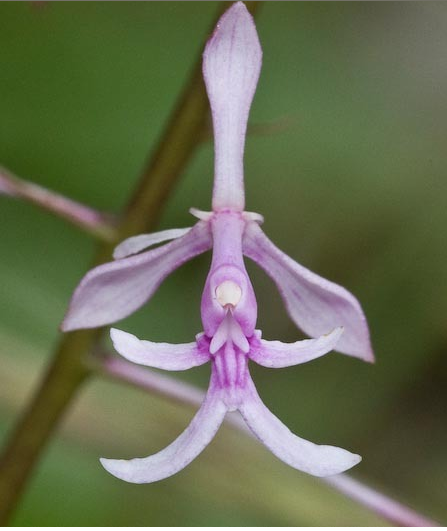

Epidendrum amplum D.E.Benn. & Christenson 1998 GROUP Pseudepidendrum SUBGROUP Porphyreum
Photo by © Quintin Lake and his Architectural Photography website
Photo by © Eric Hunt.
Drawing by © Jimenez, Hágsater & E.Santiago and The AMO Herbario Website


 LATE
LATE

Common Name The Extensive Inflorescence Epidendrum [refers to the massive inflorescence with the branches all held in a single plane]
Flower Size .6" [1.5 cm]
Found in Ecuador, Peru and Bolivia in wet montane forests on steep brush covered slopes at elevations of 1100 to 2000 meters as a giant sized, cool growing terrestrial reed stem orchid with erect, terete, cane-like stems enveloped by persistent leaf bearing sheaths and carrying many coriaceous, lanceolate, acute-acuminate, basally clasping leaves that as the plant matures are held more towards the apex and blooms in the late winter and spring on a terminal, paniculate, many branched, each branch 10"+ [25 cm+] and held in a single plane, many flowered inflorescence carrying pink, fragrant flowers.
The flower in the second photo according to Dr Eric Christenson is or is close to E amplum, the first photo is much closer to the type.
"Epidendrum amplum belongs to the GROUP Pseudepidendrum which is characterized by caespitose plants, cane-like stems, acute to acuminate leaves, apical inflorescence, lacking a spathaceous bract, the petals filiform and the lip usually 3-lobed, with 3 parallel fleshy keels, the apical lobe often bifurcate, and the pollinia “bird-wing” type and SUBGROUP Porphyreum which has flowers colored reddish orange, deep purple or lilac-pink, the calli generally prominent, sometimes horn-like. The species is recognized by the tall plants, large panicle with numerous violet, very fragrant flowers (not mentioned by Bennett & Christenson), the sepals .3 to .44" [7.5 to 11 mm] long, and the leaves 1.36 to 2.6" [3.4 to 6.5 cm] wide; the apical lobes of the lip are much longer and narrower than the basal lobes. It closely resembles E. jasminosmum Hágsater & Dodson, which has pale green and snow-white flowers, slightly larger sepals .4 to .52" [10 to 13 mm], narrower leaves .48 to .72" [1.2 to 1.8 cm] wide, and is found atelevations of 400 to 1350 meters in the Amazon basin in southern Ecuador and northern Peru. It has been confused with Epidendrum atacazoicum Schltr. from eastern Ecuador, which has a compact, pyramid-like inflorescence, with non-fragrant, rosy-lilac flowers with the lateral lobes of the lip proportionately shorter than the apical lobes." Hagsater etal 2010
Synonyms Epidendrum paniculatum var longicrure Lindl. 1853
References W3 Tropicos, Kew Monocot list , IPNI ; *Icones Orchidacearum Peruviarum plate 447 Christenson & Bennett 1998 drawing fide [for 1st flower photo]; AOS Bulletin Vol 68 No 2 1999 drawing fide; Rudolf Schlechter Die Orchideen Band 1C lieferung 42 - 43 pg 2626 - 2762 Brieger 2001; Icones Orchidacearum 4 Plate 447 Hagsater 2001 see recognition section; Icones Orchidacearum 4 Plate 447 Hagsater 2001 as Epidendrum paniculatum var. longicrure see recognition section; Orchids of Bolivia Vol 2 Laelinae Vasquez and Ibisch 2004 drawing/photo fide; Orchid Species of Peru Zelenko Bermudez 2009 photo fide; Orchid Digest Vol 74 #3 2010 photo fide; Icones Orchidacearum 13 Plate 1303 Hagsater & Sanchez 2010 drawing fide; Icones Orchidacearum 13 Plate 1305 Hagsater 2010 see recognition section; Las Orquideas del Peru Izerskyy & Bezverhov 2011 photo fide to second photo; LANKESTERIANA 14(1) 2014
--------------------------------------------------------------------------------------------------------------------------